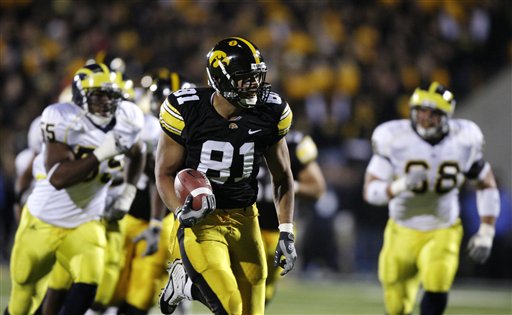But it's not like PSU has been very good this year anyway. To the numbers:
|
|
After a concussion to Bolden last week, walk-on sophomore Matt McGloin is taking over the starting quarterback role, inexplicably surpassing one-time Michigan recruit true sophomore Kevin Newsome. McGloin's first action all season was last week where he went 6/13 for 76 yards, 2 TDs, and 1 INT... against Minnesota. He only threw two passes last year, both incomplete. McGloin is a bad quarterback as you'd expect a walk-on to be, making tomorrow's game one in which Michigan's defense must succeed. If McGloin is able to get any sort of rhythm against Michigan's wretched defense, it's a referendum against every player on Michigan's D. (As an aside, Newsome, who has now been surpassed by a walk-on, was a Michigan commit who would've taken the place of Denard Robinson had he not decommitted. I'm happy with how Michigan fared here. Aren't you?)
PSU's defense isn't even the dominating unit that they have been in years past. But at least there's an explanation for that: PSU has been hit as hard, if not harder, than any program in the country by injuries. Not only should Michigan be able to stop PSU's inept offense, but the thin, injured defense of PSU should be porous, enabling Denard Robinson to return to the form we saw earlier in the year. Again: This is not the Penn State you know.
Prediction
This is, no questions asked, a must-win game for Michigan and Rich Rodriguez. Penn State's defense isn't very good and their offense may be the worst in the Big Ten. If PSU is able to put up the 500 yards and 24+ points that seemingly everyone can against Michigan, Rodriguez's job is in serious jeopardy. Penn State's offense is essentially Michigan's defense, except PSU is starting a sophomore walk-on quarterback, who has never started a game and has thrown 15 passes in his collegiate career. Michigan will completely shut down PSU's offense, generate a few turnovers, and show very few new defensive looks. With McGloin's inexperience and PSU's lackluster team, Greg Robinson will not waste new, effective defensive fronts against a team that Michigan should be able to shut down.
Any time Michigan gets a negative play (sack or penalty), expect them to get the ball back. PSU lacks the talent at quarterback to convert 3rd and long, and their run offense isn't strong enough to carry the team out of long-yardage situations. With a weak offensive line, look for Mike Martin to do a lot of damage and get to McGloin at least once. Otherwise, Michigan will probably bring more pressure than they have earlier in the year. Getting to McGloin and not allowing him to sit in the pocket will drastically increase the chance of a bad throw that results in an incompletion or interception.
Offensively, it's going to be much of the same. Michigan is going to primarily run at PSU's depleted defensive line and will do a lot of damage. Denard is probably going to break a few different runs of 20+ yards as he'll be able to get to the second level with relative ease. Expect Michigan's running backs to have a good day as well. With the bye week allowing Mike Shaw to get healthy again and, presumably, PSU forcing Denard to hand the ball of on the zone-read, Michigan should have an advantage anywhere they play. Expect Michigan to average 6.0 yards per carry against PSU.
Through the air, Denard should have a bounceback game. After two shaky performances against MSU and Iowa, due at least in some part because of a sore shoulder that should be (mostly) healed after the week off, Denard will be able to find open receivers as PSU has to overcompensate for being gashed on the ground. Denard will finish the game without throwing a pick and will stop grounding a lot of those 7-yard hitch routes that he's been having trouble with the last two games.
As always, winning the turnover battle will be key. This is the first week in the last three that Michigan comes out on top here. McGloin throws two or three interceptions and we'll also see appearances by Kevin Newsome to try and keep Michigan's defense honest. The PSU offense should be in serious trouble, even against an awful defense like Michigan's. When Michigan has the ball, expect them to move as fluidly as they have all year but without the turnovers that have plagued the team in the last few weeks. Denard will rush for significantly more than 100 yards and breaks at least one long TD run. Michigan should win this easily. Michigan 35-17







































